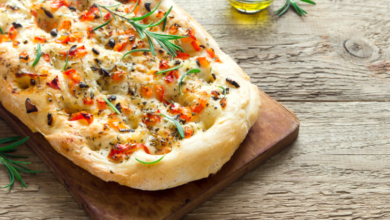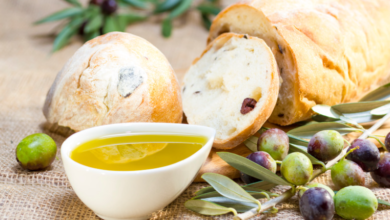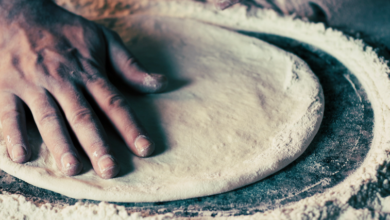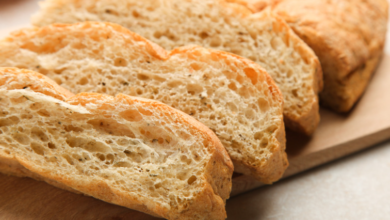Ciabatta Vs. Focaccia: Here’s Why They Are Different

What To Know
- It can be served as an appetizer or main course, and can be topped with a variety of ingredients, such as cheese, vegetables, and meats.
- Ciabatta is a light, airy bread with large, open holes, while focaccia is a flatter, denser bread with a crispy crust.
- Yes, you can make ciabatta or focaccia at home with a few simple ingredients and a little bit of time.
Ciabatta and focaccia are two iconic Italian breads that share many similarities, but also have some key differences. Both are made with a simple dough of flour, water, yeast, and salt, and both are baked in a hot oven. However, ciabatta is typically characterized by its large, open holes, while focaccia is flatter and denser, with a crispy crust.
In this blog post, we will take a closer look at ciabatta and focaccia, and compare their ingredients, textures, flavors, and uses. We will also provide some tips on how to make your own ciabatta or focaccia at home.
Ingredients
Ciabatta and focaccia are both made with a simple dough of flour, water, yeast, and salt. However, there are some slight variations in the ingredients that can affect the final texture and flavor of the bread.
- Ciabatta: Ciabatta dough typically contains a higher percentage of water than focaccia dough, which gives it a lighter, more open texture. Ciabatta dough may also contain a small amount of olive oil, which adds flavor and richness.
- Focaccia: Focaccia dough typically contains a lower percentage of water than ciabatta dough, which gives it a denser, more chewy texture. Focaccia dough may also contain a variety of herbs and spices, such as rosemary, thyme, and oregano.
Texture
Ciabatta is characterized by its large, open holes, which are created by the high percentage of water in the dough. The holes also make ciabatta very light and airy.
Focaccia is flatter and denser than ciabatta, with a crispy crust. The dense texture of focaccia makes it ideal for soaking up sauces and toppings.
Flavor
Ciabatta has a mild, slightly tangy flavor. The flavor of ciabatta can be enhanced by adding olive oil, herbs, or spices to the dough.
Focaccia has a more robust flavor than ciabatta, thanks to the addition of herbs and spices. Focaccia can also be topped with a variety of ingredients, such as cheese, vegetables, and meats.
Uses
Ciabatta is a versatile bread that can be used for a variety of purposes. It can be sliced and served with soup or salad, or used to make sandwiches or paninis. Ciabatta can also be used to make croutons or breadcrumbs.
Focaccia is a hearty bread that is perfect for soaking up sauces and toppings. It can be served as an appetizer or main course, and can be topped with a variety of ingredients, such as cheese, vegetables, and meats. Focaccia can also be used to make pizza or flatbread.
How to Make Ciabatta or Focaccia at Home
Making ciabatta or focaccia at home is a relatively simple process. Here are some tips to help you get started:
- Use high-quality ingredients. The quality of your ingredients will have a big impact on the final flavor and texture of your bread. Use high-quality flour, water, yeast, and salt.
- Follow the recipe carefully. There are many different recipes for ciabatta and focaccia, so be sure to follow the one you choose carefully. Don’t be afraid to experiment with different recipes and ingredients once you have mastered the basics.
- Be patient. Making ciabatta or focaccia takes time. Don’t rush the process, and allow the dough to rise and proof properly.
- Bake the bread in a hot oven. The high temperature of the oven will help to create the characteristic crust and texture of ciabatta and focaccia.
Popular Questions
What is the difference between ciabatta and focaccia?
Ciabatta is a light, airy bread with large, open holes, while focaccia is a flatter, denser bread with a crispy crust.
Which bread is better for sandwiches?
Ciabatta is a good choice for sandwiches because it is light and airy, and it can be easily sliced.
Which bread is better for dipping?
Focaccia is a good choice for dipping because it is dense and chewy, and it can soak up sauces and toppings well.
Can I make ciabatta or focaccia at home?
Yes, you can make ciabatta or focaccia at home with a few simple ingredients and a little bit of time.
How do I store ciabatta or focaccia?
Ciabatta and focaccia can be stored in a bread box or plastic bag at room temperature for up to 3 days.
Can I freeze ciabatta or focaccia?
Yes, you can freeze ciabatta or focaccia for up to 2 months. To freeze, wrap the bread tightly in plastic wrap and then place it in a freezer-safe bag.





